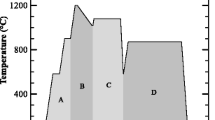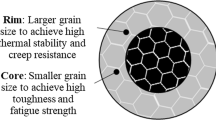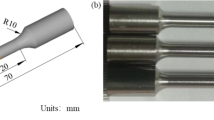Abstract
Gas turbine components made of nickel-based superalloys experience cracking after service in extreme environments. As these cracks can be wide, brazing or fusion welding is typically used to repair them. Properly designed and applied, brazing filler metal will help extend the useful life of damaged turbine components. Commercially available filler metals containing boron and silicon, including BNi-2, BNi-5, and BNi-9, were mixed at varying ratios with MARM247 to create wide-gap filler alloys. Spreading was characterized using droplets placed on a stainless steel substrate. The solidification behavior of the wide-gap braze alloys was determined through metallographic analysis of butt joint specimens with a gap of 2 mm created using René 108™ as the substrate. Mechanical properties were determined through four-point bend tests and were compared to the metallographic analysis results. Boron was found to allow the spreading of the alloys at lower temperatures in comparison to the spreading of the silicon-based alloys, but the silicon-based alloys spread over a larger area. It was found that silicon promotes the growth of a solid nickel solution during isothermal solidification, as a result of the large solid solubility limit in the Ni-Si binary system. Increased presence of this isothermally solidified nickel caused a proportional increase in the joint strength. The boron-based alloys proved to promote less isothermal solidification than the silicon resulting in weaker braze joints. Braze alloys combining both silicon-containing alloys and boron proved to retain the advantages of both melting point suppressants with few disadvantages.













Similar content being viewed by others
References
Donachie MJ, Donachie SJ (2002) Superalloys: a technical guide, 2nd edn. ASM International, Materials Park
Hoppin GS, Berry TF (1970) Activated diffusion bonding. Weld J 49(11):505s–509s
Warren Miglietti (2009) Ductile wide gap braze repairs using precious meals for stationary gas turbine engine components. in Proceedings of the 4th International Brazing and Soldering Conference, Orlando, FL
Reed RC (2006) The superalloys: fundamentals and applications. Cambridge University Press, Cambridge
Chen H, Gong J-M, Tu S-T (2009) Numerical modeling and experimental investigation of diffusion brazing SS304/BNi-2/SS304 joint. Sci Technol Weld Join 14(1):32–41
Duval DS, Owczarski WA (1967) Further heat-affect zone studies in heat resistant nickel alloys. Welding Research Supplement, pp. 423s–432s, September 1967
Prager M, Shira CS (1968) Welding of precipitation hardening nickel-base alloys. Weld Res Counc Bull 6:128–155
Duvall DS, Owczarski WA, Paulonis DF (1974) TLP bonding: a new method for joining heat resistant alloys. Weld J 51(2):41s–49s
American Welding Society (1991) Brazing handbook, 4th edn. American Welding Society, Miami
Sheward GE (1985) High temperature brazing in controlled atmospheres. Pergamon Press, Oxford, UK
Su CY, Chou CP, Wu BC, Lih WC (1999) Microstructural characterization of transient liquid phase zone of activated diffusion brazed nickel base superalloy. Mater Sci Technol 15:316–322
Su CY, Lih WC, Chou CP, Tsai HC (2001) Activated diffusion brazed repair for IN738 hot section components of gas turbines. J Mater Process Technol 115:326–332
Xinjian Y, Myung Bok K, Chung Yun K (2009) Characterization of transient- liquid-phase-bonded joints in a duplex stainless steel with a Ni-Cr-B insert alloy. Mater Charact 60:1289–1297
Xinjian Y, Chung Yun K, Myung Bok K (2009) Microstructure and XRD analysis of brazing joint for duplex stainless steel using a Ni-Si-B filler metal. Mater Charact 60:923–931
Pouranvari M, Ekrami A, Kokabi AH (2013) Solidification and solid state phenomena during TLP bonding of IN718 superalloy using Ni-Si-B ternary filler alloy. J Alloys Compd 563:143–149
Demo WA, Ferrigno SJ (1992) Brazing method helps repair aircraft gas-turbine nozzles. Adv Mater Process 131(3):43–45
Warren Miglietti (2008) High strength, ductile wide gap braze joints for stationary turbine component repairs. Engineering, University of Pretoria, PhD Thesis
Acknowledgments
This paper was based on work completed at the Colorado School of Mines with funding from the National Science Foundation Industry/University Cooperative Research Center for Integrative Materials Joining Science for Energy Applications and support from General Electric.
Author information
Authors and Affiliations
Corresponding author
Additional information
Doc. IIW-2459, recommended for publication by Commission XVII “Brazing, Soldering, and Diffusion Bonding.”
Rights and permissions
About this article
Cite this article
Nelson, S.D., Liu, S., Kottilingam, S. et al. Spreading and solidification behavior of nickel wide-gap brazes. Weld World 58, 593–600 (2014). https://doi.org/10.1007/s40194-014-0144-9
Received:
Accepted:
Published:
Issue Date:
DOI: https://doi.org/10.1007/s40194-014-0144-9




